We have one full day in Salamanca (pop 144,825 in 2020). The old city is a gumdrop-shaped bubble on a kink on the north bank of the Rio Tormes. Here, the Tormes turns from running north to west toward the Portuguese border, where it joins the Duero (Douro). The big attractions in town are the twin cathedrals, and after breakfast, we head southwest in their direction, passing through the ancient campus (est 1218) of the Universidade de Salamanca.
Many of the buildings are simple, sandy constructions, with plateresque reliefs and cornices dressing their facades; most of this stock must date from around the sixteenth of seventeenth centuries.
Our first monument is the Iglesia de San Benito (late 15th century), and oddly formed, buttressed chapel but with a wonderful, almost enigmatic south-side entrance. The sculpted panel over the door shows an Anunciación scene, with Dios Padre above holding the sphere of the Earth. The single, spindly column holding the canopy looks more than a little suspect.
Further downtime Calle del Compañía there is a memorial to "El Celebre Poeta D. Juan Meléndez Valdés", just north of the steps to La Clerecía (17th century). The La Clerecía looks very different in daylight, and the street is busy with trucks and vans making morning deliveries.
La Casa de las Conchas (late 15th century) looks very different, too – much less theatrical, almost playful. Once the home to Rodrigo Maldonado de Talavera, a sixteenth century knight in the Orden de Santiago (thus the shells), it is now a public library. The shield with the five fleur-de-lis is the Maldonado crest; the condition of the carvings is mind-boggling – they look so fresh.
The interior courtyard is more subdued, but no less compelling; the lions watch our approach. We step into the stacks to warm and rest, and page through the architecture books on the shelves near the door.
Next we enter the Patio de Escuelas, and turn to face the east doors of the Escuela Mayor's. We stare into the swirl of 'plateresco' embellishments to find the Rana de Salamanca on one of the sculpted skulls (Rick Steves' instruction). Here, a sapo (toad), is mistaken for a rana (frog); a sapo is a mythical symbol for lust and laziness.
The west wall of the Patio is covered in faded crimson brown 'vítor' graffiti, left by those who finished their degrees. The graffiti enhances rather than detracts from the Patio.
To the south is another beautifully carved entrance, this for the Rectorado and the Hospital., which features another Anunciación as well as the royal crest of Castilla y León.
Through a small alley, we find the Patio de Escuelas Menores, a grassy, intimate space. There is a doorway into the Sala de Exposiciones with comic book-like illustration explaining some historical account. The timber ceiling is one of the best we've seen.
Touches of the same reddish-brown graffiti stretch over the blocks of the gate arches. In amongst all the tracery, dog-faced creatures enjoy the company of two-headed eagles, and mischievous chimeras and grotesques.
From the Patio de Escuelas, it's a left run, and we're back at the west facade of the Catedral Nueva (de la Asunción de la Virgen, 16th century), La Portada del Nacimiento. In the partly clouded sunlight, without the glare and shadows, the scaffolding is easier to ignore, so we may study the iconography.
At the top is the Crucifixion, with the trees and rock of Calvary intricately rendered. Four angels catch His blood in their cups, one at each hand, one at His wound, and one at His feet. Mary and John the Evangelist pray as witnesses. At the base of the Cross are darkened skulls (no frogs).
At the top of the trefoil arch is Arcángel Miguel standing on Satán. On the keystone is another angel holding a scroll – perhaps representing Mateo el Evangelista. The other three Evangelistas are represented just below around the cathedral's crest (vase with lillies): the winged ox (Lucas), the eagle (Juan), and the winged lion (Marcos), each also holding scrolls.
The Nacimiento (above the north door) shows off more incredible modeling. Mary holds the baby Jesus over a woven basket, while Joseph kneels on his hat, The ox and lamb, and some of the townspeople look on as, overhead, a chorus of cherubic angels celebrate in the coiled clouds and the rays of the Holy Spirit break through.
Just to the right, separating the two archways is, possibly, the figure San Juan Bautista in his camel hair robe.
In the Adoración de los Reyes (above the south door), Mary lifts the upright Child to the magi, who carry their gifts and stare in stunned amazement. A sheep dog and a shepherd cross the hills behind them, and the arch is lined with angels playing musical instruments.
The Catedral is dedicated to La Asunción de la Virgen, and that scene occupies the stile between the two red doors, with the date 1669.
The visitors' entrance is from the north transept, the Portada de Ramos (17th century). Here, the tympanum panels depict the Entrada de Jesús en Jerusalén – Ramos (Palm Sunday). Jesus rides the donkey with los Evangelistas (documentation says "los Evangelistas", but again only three). The excited citizens of Jerusalem lay down their cloaks and the fronds from the nearby palms as a welcome.
In the upper register San Pedro (with keys) stands to the left and San Pablo to the right.
If we follow the line of the beam over the open leaves of the doors to the left (sorry, no close-ups). In the first band we see a stork with a crayfish above and a rabbit below. Further left, we see an ox, and then in the third band we see the astronauta (1993), proof that the carvings are continuously maintained and updated as needed.
As we are entering the north transept, we are immediately at the crossing. There are five bays to the west faces, and the ambulatory is three bays deep and wide. Though there is a clear view to the south transept, there is an iron railing and wooden walkway. The spacious capillas laterales are similarly screened-off and locked. The Coro again fills the center of the nave and is two bays deep, one bay west of the crossing.
However, the second western chapel is open; the Capilla de Diego de Neyla. It contains the Renaissance-era tomb of Canónigo Diego de Neyla (died 1577); the altar features a magnificent Anunciación, and at the offering table Virgen, el Niño y San Juanito. Facing this is the sepulcher of Arcediano Roque de Vergas, with a very sad lion holding the coat of arms.
The inside of the main facade has the cathedral's crest painted onto the stone blocks, with the 'Hail Mary' prayer written in Latin (Ave Maria, gratia plena, Dominus tecum – Hail Mary, full of grace, The Lord is with thee). There are four saints painted there as well, only two clearly identified, Gregorius and Hieronymus. The other two are likely Ambrosius and Augustinus – commonly, four Padres de la Iglesia.
Offering table at the back of the Coro is also separated with a railing. Near the top is striking Pantocrátor.
In the drum of the dome, the Composite columns are fluted in sky blue, quite a novel touch. The nedned glass panels are also at an extreme distance and very hard to read. The one above the chapel at the east end of the south aisle seems to show either men kissing or fighting – maybe they're doing both.
The chancel and the La Capilla Mayor is not locked, but a sign asks tourist not to enter as the space is for worshipers. The main altar lacks a heroic altarpiece but offers a modest arrangement of painted figures. La Asunción de la Virgen (Esteban de Rueda, 1624) stands against a red curtain at the center, with two rows of four figures: the Evangelistas and the Padres de la Iglesia.
On the retable are the silver urns with the relics of San Juan de Sahagún (patron of Salamanca) and Santo Tomás de Villanueva.
In the triforium is a female saint holding a cross and (maybe?) a rope – perhaps this Santa Helena.
And in the clerestory if a stained-glass triptych – the center panel is missing so the story is illegible, the the side panels appear to present two scenes from the Vía Crucis: His arrest and His disrobing. Through the glass, the sunlight sparkles from the ingenious and dramatic bóveda estrellada (starry vault).
As expected, the Coro is carved in the 'plateresco' style. Unlike Ciudad Rodrigo, there are no obscene or monstrous figures; it's all saints and bishops.
Returning along the south aisle, we stop at La Capilla Dorada (16th century) before continuing into the Catedral Vieja. Like the Capilla Mayor, this is populated by small statues dedicated to Todos los Santos. On the south wall, favorites include Adam and Eve (center-left), and the Memento Mori (right-center) with a sapo to hide the genitals.
On the east wall, is a Calvario with statuary arranged over a painted archway. The Pantocrátor stands at the top, in a glow of holy light. The Crucifixion is composed just as in La Portada del Nacimiento. A papal figure (?) sits in a throne at the base of the Cross – perhaps as God's 'Catholic' representative on Earth.
On the west wall, is the tomb of Arcediano de Alba de Tormes, Francisco Sánchez de Palenzuela. In the corner is an interesting 'wheel of bells' contraption. And the march of saint continues with two saints on horseback, Santa Barbara (with tower) and Santa Lucía (with plate, near the bells), allegorical figures such as Iustitia (with scales), and in the center a row, from the Old Testament, Levi and Asher.
The last capilla on the south aisle contains the door to the Catedral Vieja (de Santa María de la Sede, 12th century). We enter from a narrow stair on the north aisle of the old church, stepping to the west, and descending to toward a faded blood-orange fresco. A rider is brandishing his sword, not to strike the old man, but to cut his cloak – he must be San Martín, who we met yesterday, sharing with the beggar.
The fresco frames a small door leading to the Capilla de San Martín. This would have been under the old bell tower, whose foundations now help hold the new tower. But the small chapel is filled with tourists, so we turn to face the chancel; we'll come back for the chapel later.
The nave is darker and lower; there are five bays to the crossing, and then the apse. The vaulting is simple and pure Gothic, except for some of the Corinthian capitals – to an architect's eyes, that's like seeing astronauts in the archivolts. The bundled piers are thick and solid; everything is so clean, so perfect.
Along the north wall is a Gothic 'graphic novel' of images enclosed by a painted Ionic colonnade. Reading the texts in the cartouches, the panels seem to link local events in and around Salamanca to the powers of the Catholic church. (perhaps when the side chapels were demolished for the Catedral Nueva, this gave the church something to offer its benefactors).
Just below the panels is the vault of Canónigo Diego de Vera y Paz, which dates from 1660; this includes El Altar de Santa María la Blanca.
The imposition of the Catedral Nueva is evident in the Capilla lateral del Evangelio, whose semi-circular shape is chopped flat. Unusually, baptismal font is on display here rather than near the front, along with a marvelous Gothic altarpiece featuring San Lorenzo (with gridiron).
The cúpula appears to a hemispherical dome on a raised drum, giving this Gothic construction a classical feel. The ribs divide the dome into sixteen, and the church's documentation refers to this as la media naranja, half an orange.
The Capilla Mayor is breathtaking (Daniel, Sansón, and Nicolás Delli, 15th century), adding a Renaissance 'punchline' to the Gothic 'setup'. The panels tell of Mary's and Jesus' lives, and read from the lower left to upper right – here are some that are easy to spot:
bottom row left:1 La Natividad de la Virgen – Her 'immaculate' birth, with Santa Ana and San José
3 La Anunciación – Arcángel Gabriel and El Espíritu Santo with Santa María
4 La Visitación – Santa María tells Isabel about her child
5 El Sueño de José – San José dreams, with pregnant Santa Maríabottom row right:1 La Nacimiento – subdued manger scene3 La Adoración de los Reyes Magos – colorful Reyes Magos5 La Huida a Egipto – Santa María on horseback with San Josésecond row left:3 El Bautismo de Jesús – Jesús and San Juan Bautista4 Las Tentaciones de Jesús – Jesús and El Diablo (green wings, bird feet)second row right:3 Las Bodas de Caná – Jesús at a table and wine jarsmiddle row left:3 La Unción en Betania – anointing of Jesús in Betaniamiddle row center:1 Curación de la Hemorroisa – Jesús cures a bleeding woman
middle row right:1 La Transfiguración – Jesús radiant with glory2 Expulsión de los Mercaderes – Jesús angry at money changers
fourth row left:1 La Cena en Casa de Simón – Jesús, Apóstoles with Simón el leproso4 La Última Cena – Jesús and Los Doce Apóstoles5 Lavatorio – Jesús washes feet of Apóstolesfourth row center:1 El Beso de Judas – Judas kisses Jesúsfourth row right:1 Flagelación a la Columna – Jesús is whipped at the column2 Vía Dolorosa – Jesús carries the Cross3 La Crucifixión – Jesús on the Cross at Calvary4 El Descendimiento – Jesús descends from the Crosstop row left:3 Resurrección de Jesús – Jesús rises from His tomb5 Noli me tangere – Jesús speaks to María Magdalenatop row center:1 Emaús – Jesús talks to two disciples (San Juan Bautista?)top row right:4 La Asunción de la Virgen – Santa María rises from Her tomb5 La Coronación de la Virgin – Jesús crowns Santa María
La Virgen de la Vega (12th century) is set in the center inside a Gothic aedicula. And finally, El Juicio Final (Nicolás Delli, 1445, top image) is in the quarter dome above the altar; it dominates the Catedral and is decipherable from the opposite end of the nave. An agitated Jesús leads six angels carrying the Arma Christi, and two trumpeters calling the Apocalipsis. San Juan Bautista is on His right and Santa María is on His left, both in prayer. Below, the blessed dead rise in white robes, while the wicked march naked to their doom, into the maw of the great, green Beast.
The south transept of the Catedral is not chopped and is full of fascinating Gothic-era sepulchers and artwork. We envisage the gorgeous polychrome patterns and shapes spread over the entire Catedral, and how it must have felt to be in such an interior.
Looking into the vault, the arches, cornices, and ribs are knurled and wavy. The spring blocks seem to call to the art of indigenous people from the times of Columbus and Magellan. But the block work and the clerestory openings are Romanesque, and so the mixing of times and eras goes on.
The exit to thtriutro is in the corner of the transept – a moment to quickly double-back and see if the Capilla de San Martín (13th century) is empty, and it is. Here we do get a better sense for the 'full package' of Gothic decoration, though maybe a little faded. The wall surface also carries a patina; by comparison, the south transept might be too clean.
We may also compare this Juicio Final, with Christ inside a medieval mandorla, enthroned and encircled by angels. On either side are the sun and moon, and the Apóstoles and Santa María, all called out with cartouches. At the lower right is the great Beast, looking like a towering dragon.
In the corner is the tomb of Obispo Rodrigo Díaz (14th century), with another Adoración de los Reyes Magos.
Now, we go out to the Claustro (12th century, rebuilt 18th century). While there may be two cathedrals, there's only this one cloister; it is undersized for supporting the Catedral Nueva, but packed with huge mix of art, sculpture, and architecture. The Catedral's documentation tells us the Claustro partially collapsed and was rebuilt after the 1755 Lisbon Earthquake, and so we have this collection of parts.
La Capilla de San Salvador is the first of the chapels here. The inset arches span the corners of this square room, which is thus covered with an octagonal 'star dome' with a distinctly Mozárabe look. This contains the crypt of Rodrigo Maldonado, owner of the Casa de las Conchas (note the family crests): the dome is Romanesque, the altar is Baroque, the arch panels are Renaissance (Los Cuatro Evangelistas), the dedications date to 1562.
Next door is the La Capilla de Santa Bárbara (14th century), another square with an octagonal dome. Santa Bárbara, patron of architects, mathematicians, and engineers (we saw her holding the tower), is shown in her martyrdom in the lower right altar painting. The literature tells us that the Univeristy's graduations were once held here until 1843.
Nearby is the crypt of Obispo Juan Lucero, who founded the chapel.
We finish in the La Capilla de San Bartolomé (16th century) and the funerary enclosure of Arzobispo Diego de Anaya, set within an elaborate plateresque fence.
After two cathedrals in one go, we are finally back outside. We exit near the southern portal which remains unfinished. All the niches are empty, save the two near the doors, ready for more saints, or toads, or astronauts.
We stop in the Plaza de Anaya for a breath and to process all we've seen on this monumental morning. The Iglesia de San Sebastián (18th century) stands in front of us, the saint shot through with arrows.









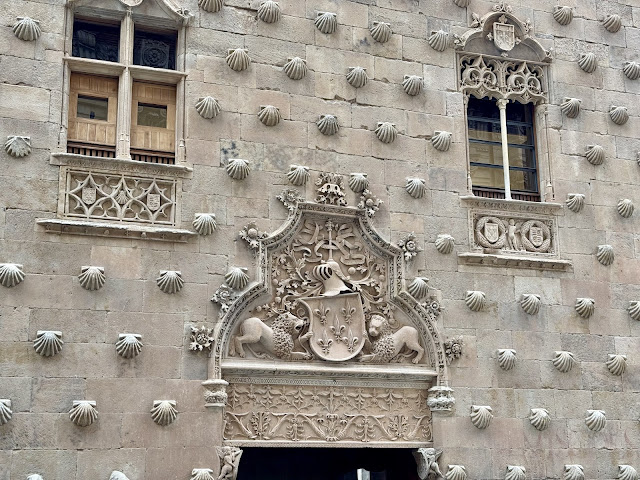













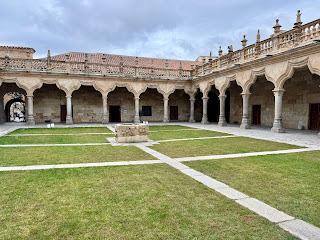






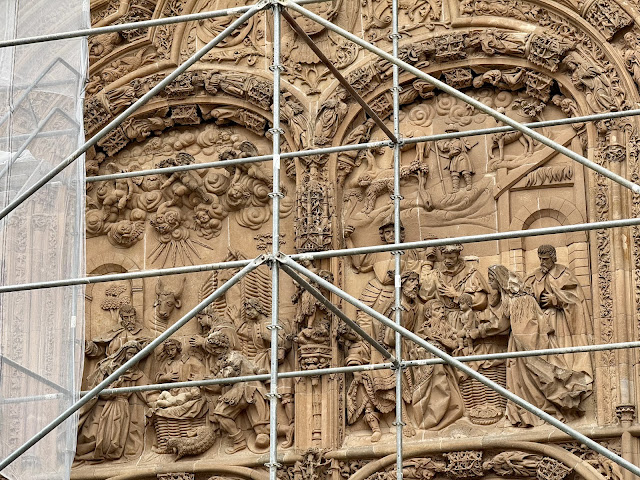
























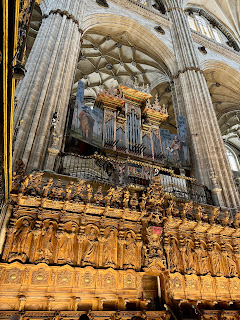





















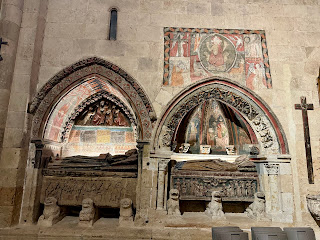











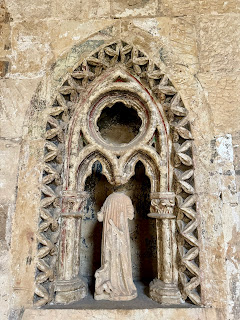


















No comments:
Post a Comment